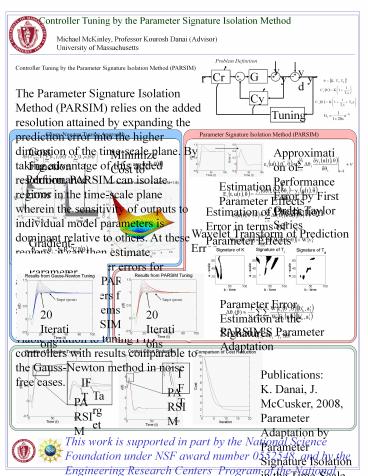CASA POster Template PowerPoint PPT Presentation
Title: CASA POster Template
1
Controller Tuning by the Parameter Signature
Isolation Method
Michael McKinley, Professor Kourosh Danai
(Advisor) University of Massachusetts
Problem Definition
Controller Tuning by the Parameter Signature
Isolation Method (PARSIM)? The Parameter
Signature Isolation Method (PARSIM) relies on the
added resolution attained by expanding the
prediction error into the higher dimension of the
time-scale plane. By taking advantage of this
added resolution, PARSIM can isolate regions in
the time-scale plane wherein the sensitivity of
outputs to individual model parameters is
dominant relative to others. At these regions, it
can then estimate individual parameter errors for
adaptation. Here, PARSIM is applied to tuning
controllers for single-input single-output
systems. The results indicate that PARSIM
provides a viable solution to tuning PID
controllers with results comparable to the
Gauss-Newton method in noise free cases.
Gauss-Newton Tuning Approach
Parameter Signature Isolation Method (PARSIM)
Cost Function
Approximation of Performance Error by First Order
Taylor Series
Minimize Cost to Achieve Optimal Performance
Performance Error
Estimation of Parameter Effects
Estimation of Prediction Error in terms of
Parameter Effects
Wavelet Transform of Prediction Error
Gradient-based Parameter Adaptation
Parameter Error Estimation at the Signatures
Target (green)
Target (green)
20 Iterations
20 Iterations
PARSIM'S Parameter Adaptation
Publications K. Danai, J. McCusker, 2008,
Parameter Adaptation by Parameter Signature
Isolation in the Time-Scale Domain. ASME J. of
Dynamic Systems Measurement and Control,
accepted. K. Danai, J. McCusker, and M.
McKinley, 2008, Iterative Controller Tuning by
Signature Isolation in the Time-Frequency Domain.
working paper.
This work is supported in part by the National
Science Foundation under NSF award number
0552548, and by the Engineering Research Centers
Program of the National Science Foundation under
award number 0313747, James M. Smith, 67, and
the Deans Fund for Undergraduate Research in
Engineering established in honor of Joseph I. and
Barbara H. Goldstein. Any opinions, findings,
conclusions, or recommendations expressed in this
material are those of the authors and do not
necessarily reflect those of the National Science
Foundation.

